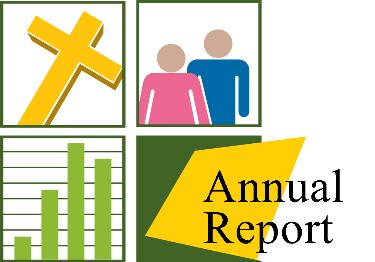The number one reason people give to their congregation, or any other charity, is because they believe that organization makes a difference. A colorful annual report on your congregation’s ministries and missions will help members and guests feel positive about your church.
Do not focus on facts and plans for the future but the current successes of your congregation. You will be successful when a church member shares the brochure with a friend and says proudly, “This is my church!”
This annual report may be as small and focused as a colorful brochure. Celebrate with a few short sentences and some pictures of the essential ministries of your congregation: the pastor visiting an older member, musicians singing, children on a playground, and youth on a mission. As you create such a brochure, do not focus on facts and plans for the future but the current successes of your congregation. You will be successful when a church member shares the brochure with a friend and says proudly, “This is my church!”
The annual report may be a larger (four to ten pages) review. Again, focus primarily on stories and pictures, not facts and figures. Describe the following in your congregation: worship, children’s ministry, youth ministry, upkeep of the church property, staff, local missions, and global missions. In these colorful pages, celebrate for example a major worship experience at Christmas or Easter, Vacation Bible School, a youth retreat, a new roof, the cost of health insurance, the price of the copier, work with the homeless shelter, a mission team, etc. Show pictures of staff and even more pictures of members doing ministry. Provide inspirational stories and pictures of accomplishment. If it takes more than fifteen minutes to read it, your annual report is too long.
This annual report may also include some limited financial information. But keep it to no more than two pages.
- Share in just a few lines how money in your congregation is collected, counted, deposited, and checks written. If you have an annual audit or financial review, include the few key sentences that demonstrate that your congregation is a faithful and transparent steward of its resources.
- Give an outline of how money is spent. Very few persons want to see a detailed budget. If someone wants to see the detailed budget, usually they are persons who are concerned about one particular ministry or another, so show it to them. Most persons, however, like just a general overview. This might take the form of a pie-chart illustrating what percentage of the budget supports youth ministry, adult education, apportionments, worship, mission, and so forth.
- Include a stair step graphic showing the giving levels of the members of your congregation. People like to know how their giving relates to the generosity of their fellow members.
This article is reprinted with permission from the leaders’ guide to Andy and Mark’s recently published stewardship module, The Pyramid of Christian Generosity: A Congregational Financial Stewardship Strategy, available at www.pofcg.com.
Related Resources:






